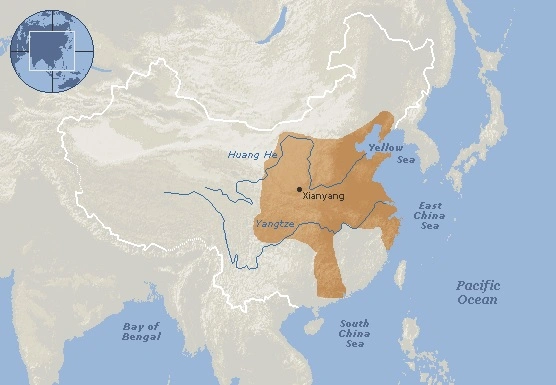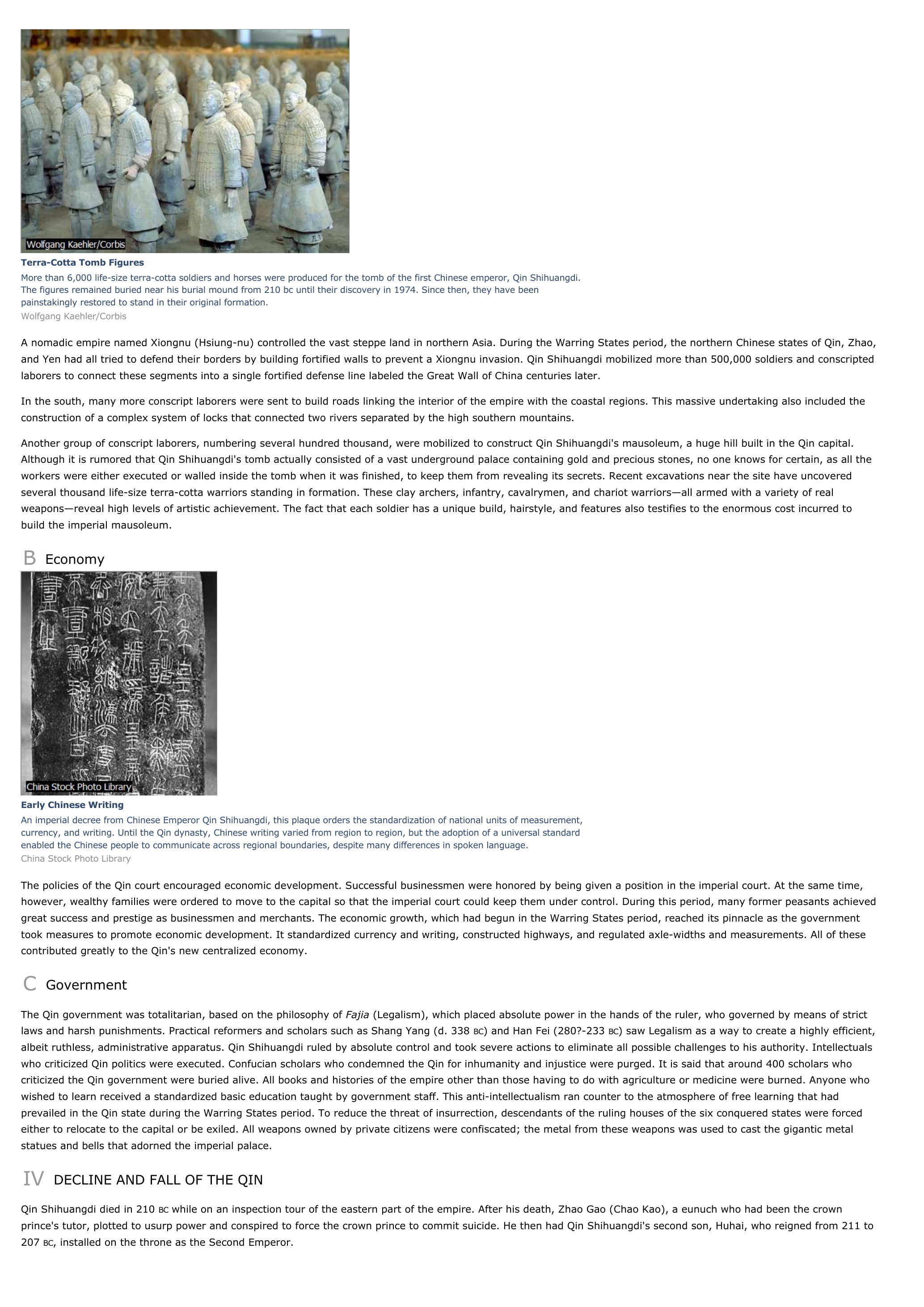Qin Dynasty - history.
Publié le 26/05/2013

Extrait du document


«
Terra-Cotta Tomb FiguresMore than 6,000 life-size terra-cotta soldiers and horses were produced for the tomb of the first Chinese emperor, Qin Shihuangdi.The figures remained buried near his burial mound from 210 bc until their discovery in 1974.
Since then, they have beenpainstakingly restored to stand in their original formation.Wolfgang Kaehler/Corbis
A nomadic empire named Xiongnu (Hsiung-nu) controlled the vast steppe land in northern Asia.
During the Warring States period, the northern Chinese states of Qin, Zhao,and Yen had all tried to defend their borders by building fortified walls to prevent a Xiongnu invasion.
Qin Shihuangdi mobilized more than 500,000 soldiers and conscriptedlaborers to connect these segments into a single fortified defense line labeled the Great Wall of China centuries later.
In the south, many more conscript laborers were sent to build roads linking the interior of the empire with the coastal regions.
This massive undertaking also included theconstruction of a complex system of locks that connected two rivers separated by the high southern mountains.
Another group of conscript laborers, numbering several hundred thousand, were mobilized to construct Qin Shihuangdi's mausoleum, a huge hill built in the Qin capital.Although it is rumored that Qin Shihuangdi's tomb actually consisted of a vast underground palace containing gold and precious stones, no one knows for certain, as all theworkers were either executed or walled inside the tomb when it was finished, to keep them from revealing its secrets.
Recent excavations near the site have uncoveredseveral thousand life-size terra-cotta warriors standing in formation.
These clay archers, infantry, cavalrymen, and chariot warriors—all armed with a variety of realweapons—reveal high levels of artistic achievement.
The fact that each soldier has a unique build, hairstyle, and features also testifies to the enormous cost incurred tobuild the imperial mausoleum.
B Economy
Early Chinese WritingAn imperial decree from Chinese Emperor Qin Shihuangdi, this plaque orders the standardization of national units of measurement,currency, and writing.
Until the Qin dynasty, Chinese writing varied from region to region, but the adoption of a universal standardenabled the Chinese people to communicate across regional boundaries, despite many differences in spoken language.China Stock Photo Library
The policies of the Qin court encouraged economic development.
Successful businessmen were honored by being given a position in the imperial court.
At the same time,however, wealthy families were ordered to move to the capital so that the imperial court could keep them under control.
During this period, many former peasants achievedgreat success and prestige as businessmen and merchants.
The economic growth, which had begun in the Warring States period, reached its pinnacle as the governmenttook measures to promote economic development.
It standardized currency and writing, constructed highways, and regulated axle-widths and measurements.
All of thesecontributed greatly to the Qin's new centralized economy.
C Government
The Qin government was totalitarian, based on the philosophy of Fajia (Legalism), which placed absolute power in the hands of the ruler, who governed by means of strict laws and harsh punishments.
Practical reformers and scholars such as Shang Yang (d.
338 BC) and Han Fei (280?-233 BC) saw Legalism as a way to create a highly efficient, albeit ruthless, administrative apparatus.
Qin Shihuangdi ruled by absolute control and took severe actions to eliminate all possible challenges to his authority.
Intellectualswho criticized Qin politics were executed.
Confucian scholars who condemned the Qin for inhumanity and injustice were purged.
It is said that around 400 scholars whocriticized the Qin government were buried alive.
All books and histories of the empire other than those having to do with agriculture or medicine were burned.
Anyone whowished to learn received a standardized basic education taught by government staff.
This anti-intellectualism ran counter to the atmosphere of free learning that hadprevailed in the Qin state during the Warring States period.
To reduce the threat of insurrection, descendants of the ruling houses of the six conquered states were forcedeither to relocate to the capital or be exiled.
All weapons owned by private citizens were confiscated; the metal from these weapons was used to cast the gigantic metalstatues and bells that adorned the imperial palace.
IV DECLINE AND FALL OF THE QIN
Qin Shihuangdi died in 210 BC while on an inspection tour of the eastern part of the empire.
After his death, Zhao Gao (Chao Kao), a eunuch who had been the crown prince's tutor, plotted to usurp power and conspired to force the crown prince to commit suicide.
He then had Qin Shihuangdi's second son, Huhai, who reigned from 211 to207 BC, installed on the throne as the Second Emperor..
»
↓↓↓ APERÇU DU DOCUMENT ↓↓↓
Liens utiles
- Qin Dynasty - History.
- Qing Dynasty - history.
- Han Dynasty - history.
- Shang Dynasty - history.
- Han Dynasty - history.
















